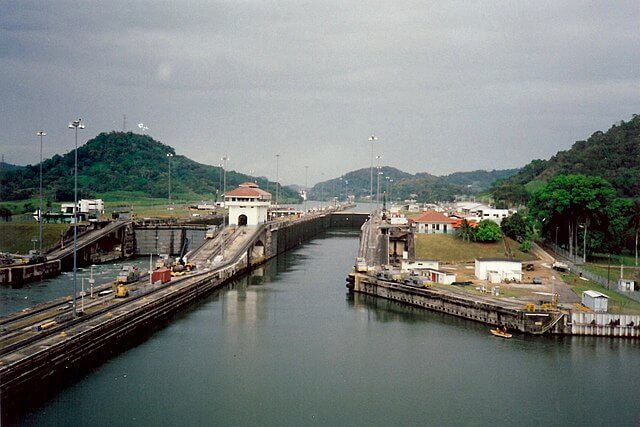
A severe drought, commencing last year, has compelled authorities to significantly reduce ship transits by 36% through the Panama Canal, a pivotal global trade route.
The impact on the canal’s figures exceeds initial expectations, with administrators now estimating potential losses between $500 million and $700 million in 2024, a stark contrast to the earlier projection of $200 million.
This unprecedented drought in Central America has disrupted the 50-mile maritime route, causing a backlog of vessels and raising concerns about the canal’s reliability and its broader implications for international shipping and global trade.
Since its inauguration in 1914, the canal has been instrumental in revolutionising global shipping by connecting the Atlantic and Pacific Oceans, eliminating the need for perilous journeys around South America’s southern tip and shortening trips by over 13,000 km.
Panama Canal administrator Ricaurte Vasquez disclosed that daily ship transits would be reduced to 24, down from the normal 38 in pre-drought times. The first quarter of the fiscal year witnessed a 20% decrease in cargo and 791 fewer ships compared to the same period the previous year.
Despite these challenges, improved water management and increased rainfall in November allowed the canal to sustain adequate water levels for the reduced transits until the end of April, marking the onset of the next rainy season.
Attributing the drought to the El Niño weather phenomenon and climate change, canal authorities emphasised the urgency of finding new water sources for both canal operations and human consumption in Panama. The lakes supplying the canal also cater to over 50% of the country’s population of more than four million.
The critical question now looms over whether the current water shortage is a singular event caused by El Niño or a forewarning of the potential impacts of climate change on the canal, its operators, global traders, and the millions relying on the water reservoirs of Lake Gatun.
Steven Paton, of the Smithsonian Tropical Research Institute, said “I certainly am beginning to believe that the patterns we’ve come to know in the last 30 years are no longer a useful guide in helping us predict the future.”
“Historically there has been a [rainfall] shortage on average once every 20 years due to major El Niño events. In the last 26 years this is the third major rainfall deficit. So it seems that something is changing our rainfall patterns.”
Statistically what is going on now “has no analogue in the previous 100 years of data,” he adds.
——————————————————————————
At Natural World Fund, we are passionate about stopping the decline in our wildlife.
The decline in our wildlife is shocking and frightening. Without much more support, many of the animals we know and love will continue in their decline towards extinction.
When you help to restore a patch of degraded land through rewilding to forests, meadows, or wetlands, you have a massive impact on the biodiversity at a local level. You give animals a home and food that they otherwise would not have had, and it has a positive snowball effect on the food chain.
We are convinced that this is much better for the UK than growing lots of fast-growing coniferous trees, solely to remove carbon, that don’t actually help our animals to thrive.
This is why we stand for restoring nature in the UK through responsible rewilding. For us, it is the right thing to do. Let’s do what’s right for nature!
Donate today at https://naturalworldfund.com/ and join in the solution!

